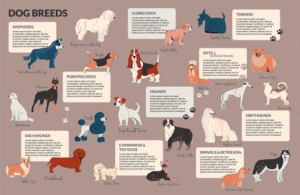Selective Breeding: Understanding Your Dog’s Temperament via Breed Type!
Dogs have been our faithful companions for centuries, providing us with assistance, protection, companionship, and more. However, not all dogs possess the same temperament or behavioral traits. Have you ever wondered why certain breeds are known for their calm and loyal nature, while others are more energetic and independent? The answer lies in the fascinating world of selective breeding, how different breeds were formed, and how to look to both the breed standard as well as your dog (as a unique individual with a mind of their own) to get the most out of training and your relationship!
The Basics of Selective Breeding
Selective breeding is a process that humans have employed for thousands of years to produce offspring with specific characteristics. In the context of dogs, this practice has allowed humanity to create the myriad of man-made breeds we see today.
In order to achieve trait dominance that will be produced for years to come via selective breeding, knowledgeable breeders often spend years researching and choosing parents that have the desired traits they want to reproduce, before then breeding them together to increase the likelihood of generational offspring that also have those same traits. Over time, this process has led to the development of hundreds distinct breeds, each with its own distinct physical structure, temperament, and behavioral tendencies.
The Role of Genetics
An organism’s characteristics, including breed temperament, are influenced by its genes. Genes are segments of DNA that contain instructions for the development and functioning of an organism, which are often activated by hormonal changes in the body itself. When two dogs with specific temperament traits are bred together, their offspring inherit a combination of genes that contribute to their temperament, physical structure, health, and more.
While a discussion on DNA and genes can become complicated quickly, in short it’s important to realize that each parent contains two (2) separate genes for most traits, and will pass one (1) of those genes off to it’s offspring. The type and amount of genes received by the fetus are what then sets a “blueprint” for what that in-utero puppy is going to become; both good and bad.
Key Factors in Selective Breeding for Breed Temperament
When selectively breeding for breed temperament, certain factors are almost uniformly considered by knowledgeable breeders:
1. Drive: Drive refers to a dog’s motivation or desire to perform a specific behavior. Different breeds may have varying levels of drive, such as prey drive, hunt drive, guarding drive, herding drive, or hunting drive (and yes, there is a difference between hunt drive and hunting drive). Selective breeding can amplify or diminish these drives based on the desired breed temperament.
2. Trainability: Trainability reflects a dog’s ability to learn and respond to training commands. Breeds that are highly trainable are often more obedient and easier to handle. Selective breeding can enhance trainability by breeding dogs with a natural inclination to follow instructions and learn new behaviors.
3. Behavioral Traits: Selective breeding can be used to emphasize or suppress specific behavioral traits. For example, breeding for a calm and gentle temperament may result in a breed that is well-suited for therapy or as a family companion. Conversely, breeding for amore assertive and independent temperament may produce a breed more suitable for other types of working or guarding roles.
Factors that Directly Impact Temperament
Selective breeding has a profound impact on breed temperament, shaping the behavior and characteristics of different dog breeds. However, it is important to note that breed temperament is not the sole factor determining an individual dog’s behavior. Environmental factors, socialization, and training also play significant roles.
Breed-Specific Temperament
Each breed has its own unique temperament traits, which are the result of careful selective breeding over many generations to set a “standard” for the breed. For example, Golden Retrievers are known for their friendly and outgoing nature, making them excellent family pets, service dogs, and therapy dogs – while on the other hand, Border Collies have a strong herding instinct and exceptional intelligence, making them well-suited for high energy sports and working roles.
Variability Within Breeds
While breed temperament provides a general framework for understanding a dog’s behavior, it is also essential to recognize that there can be variability within breeds due to a division in regional breed standards and trends (i.e., the “American vs European Doberman”) the individual breeder’s program goals, and even recessive “throwback” traits that appear unexpectedly in some litters. Individual dogs and their direct family lines may also exhibit variations in temperament and drive influenced by genetic factors, early experiences, and socialization. Therefore, it’s vital to not only consider a breed’s temperament when searching for a new 4-legged best friend, but to also consider where your new dog is coming from and what they may have experienced prior to meeting you for the first time.
Impact on Pet Selection
Understanding breed temperament is crucial when selecting a dog that aligns with your lifestyle, preferences, and needs. By considering the breed’s inherent traits, you can choose a dog that is more likely to fit well into your home and family dynamics. For example, if you’re extremely active and enjoy outdoor activities, a breed with high energy levels and a strong drive for exercise may be a great match. On the other hand, for some older individuals, those with health issues, or even people that prefer calmer hobbies and pursuits; a more laid-back breed may be what they really need!
When in doubt, or if you aren’t sure about what the breed standard says for a particular breed you are interested in, take the time to look up the AKC Parent Club for that breed! They are almost always a wealth of information you just can’t get elsewhere.
Training Considerations
Breed temperament can also influence the training process in marked ways. Dogs with a high prey drive, such as certain terrier breeds, may require specialized training techniques to redirect their focus and manage their instinctual behaviors, while breeds with a strong desire to guard their property or family may need much more early socialization to help them mature into happy confident family members. Small “toy” breeds often require more intensive potty training, while larger dogs often require more thought and planning regarding “proofing” your home and ensuring breakables are placed out of reach.
Ethical Considerations in Selective Breeding by Reputable Breeders
While selective breeding has shaped breed temperament in desirable ways, it’s also imperative to address the ethical considerations associated with this process in order to fully understand its impact on the breeds we see today. Ethical breeders not only keep and maintain the breed’s written standard, but they also prioritize the health and well-being of the dogs they breed, ensuring that genetic diversity is maintained and breed-specific health issues are minimized.
Responsible Breeding Practices
Responsible breeders prioritize the overall health, drive, physical structure, and temperament of their adult breeding dogs, and prove their efforts through titling in venues and sports that coincide with the written standard of their breed. If a dog in their program has a health, conformation, or temperament issue that doesn’t conform to the breed’s standard; that dog is pulled from breeding and sharing the trait further. Additionally, truly reputable and above-board breeders microchip and rehome their puppies on contract to prevent them from ever landing in a shelter (or rescue) and adding to pet overpopulation.
Avoiding Exaggerated Traits
Extreme selective breeding for certain traits can lead to exaggerated physical or behavioral characteristics that may compromise a dog’s well-being. For example, selective breeding for an extremely short snout in brachycephalic breeds has created the issue of stenotic nares (tiny or malformed nostrils that collapse inwards), which can result inbreathing difficulties and other health issues throughout the dog’s lifetime. Ethical breeders prioritize the long-term health and functionality of their dogs over extreme physical features, and routinely remove negatively affected dogs (or those that could pass the trait on to future generations) from their breeding program.
Promoting Genetic Diversity
Maintaining genetic diversity within breeds is essential to prevent the accumulation of genetic diseases and preserve the overall health and vitality of the breed in question. While there are situations where linebreeding is acceptable (and even desirable) in assisting an experienced knowledgeable preservation breeder in restoring or preserving a breed trait; breeding for strict conformity to breed standards, without considering genetic diversity, can lead to an increased risk of inherited diseases through a “doubling-down” effect of (formerly) recessive genes. Responsible breeders spend years mentoring and researching not only their lines, but also those common to the breed’s overall history. As there is no way to health test for every malady that affects different breeds, ultimately this knowledge is integral to ensuring any newly introduced genetic material is complimentary and an improvement for both the puppies they produce, and the breed as a whole.
A Framework for Training and Socialization
Understanding your dog’s breed temperament and how it compliments or conflicts with your lifestyle and needs is crucial for effective training and socialization. While the written breed standard for temperament (which is almost always easily found on the parent breed club’s website) provides a general framework owners can start with, individual dogs within a breed may still display variations in behavior that need a period of counter-conditioning for long-term success.
Training and socialization is imperative to healthy development for ALL DOGS, but should also be tailored to the specific needs and temperament of the individual dog in front of you in order to reach your goals. After all, not only due calm Belgian Malinois and high energy bloodhounds exist, but a dog that spends its life around the hustle and bustle of New York City is going to encounter very different daily challenges than one that lives on a ranch in Montana.
Early Socialization
Early socialization plays a vital role in shaping a dog’s behavior and temperament. Exposing puppies to a variety of people, animals, and environments during their critical developmental period helps them become well-rounded and adaptable adults. Proper socialization can help prevent behavior problems and ensure a positive interaction with the world.
Breed-Specific Training Considerations
Different breeds have different learning styles and tendencies. Understanding breed-specific traits can guide training approaches and techniques. For example, breeds with high prey drive may benefit from controlled exposure to their instinctual behaviors and redirection to appropriate outlets for their energy. Breeds with strong guarding instincts may require specific training to differentiate between real threats and harmless situations.
Balanced Ethical Training
Balanced training methods, which teach your dog both “yes” and “no”, are effective for training dogs of all breeds and temperaments. These methods focus on rewarding desired behaviors, stopping unwanted behaviors, and providing clear communication between the dog and owner. Clear and effective training builds a strong teamwork bond, as well as a positive learning experience for both.
Final Thoughts
Selective breeding has played a significant role in shaping breed temperament, allowing us to have a diverse range of dog breeds with distinct characteristics and behaviors. Understanding breed temperament is crucial for pet selection, training, and providing appropriate care for a dog’s specific needs. However, it is important to remember that individual dogs within a breed can display variations in behavior, influenced by genetics, socialization, and training. By considering breed temperament and individual differences, we can create harmonious relationships with our canine companions and provide them with the best possible care and training for the duration of their lives with us!

